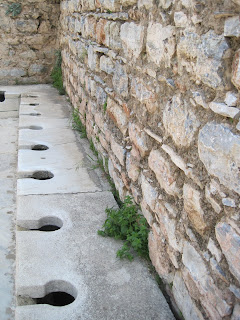Without a doubt, Turkey Asia , its history has been long and varied. Entering through Antioch, Christianity was carried by Paul, John and others along the coast and into the towns and cities of the interior, eventually finding its greatest proponents in Ephesus, Cappadocia and Istanbul.
Ephesus, located 16 miles from the port of Kusadasi, is by far one of the best-preserved ancient cities. With its brisk sea traffic, rich commerce and right of sanctuary in the Temple of Artemis, Roman Ephesus was the capital of Asia Minor and its population rapidly grew to around 250,000. Successive emperors vied with one another to beautify the city and it drew immigrants from all around the empire. Despite the fame of the cult of Diana, Ephesus St. John St. Paul
 |
| Virgin Mary's house |
 |
| Guards at Virgin Mary's house |
We began our tour by visiting the house of the Virgin Mary, where Jesus’ mother is said to have lived the last years of her life. We then moved on the Ephesus to view the Odeon Theatre, the Market Basilica, Curetes Street, the Baths, Celsius Library, Marble Street and the Great Theatre with a seating capacity of 25,000 people. We next went to view the new excavation of the Terrace Houses located opposite Hadrian’s Temple. This is a new excavation where the wealthy and important people lived. They are finely decorated with mosaics and frescoes, giving a true impression of the ancient lifestyle. We walked through the market square and through the lower gates to the bus. Our next stop was a visit to the Basilica of St. John, where St. John is buried. It is located in the small village of Selcuk. We were taken to a carpet weaving school for lunch in their lovely garden. After lunch we were treated to a demonstration on the age-old tradition of handmade Turkish rugs. We saw some storks on a nest looking after their eggs in the parking lot of the church. We have 2 days in Kusadasi, Turkey. Tonight we spent time in an internet café on shore and I managed to work on this blog for awhile.
Kusadasi means “Bird Island”. It is a mecca for sun worshippers and historians alike. This is where East meets West. The Kale district is the oldest and most appealing part of the town. Surrounded by walls, it houses many traditional establishments, including the Kale Mosque. We explored Kusadasi on our own on the second day. We began by walking along Blvd. Ataturk along the bay. It is a most beautiful port. We then walked into the Kale District the oldest and most appealing part of town. We then decided to visit the bazaars. We went to the Old Bazaar, the Orient Bazaar and the Grand Bazaar.
 |
| Public toilets at Ephesus |
 |
| Terrace houses |
 |
| Basilica of St. John |
 |
| Lunch on tour |


No comments:
Post a Comment